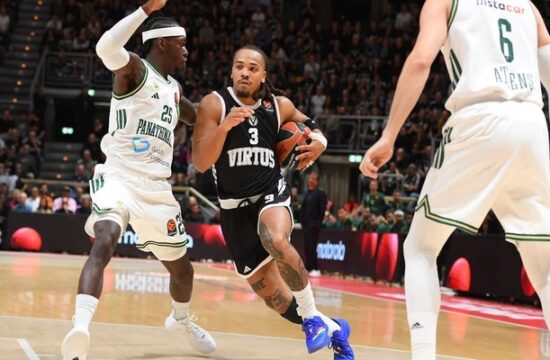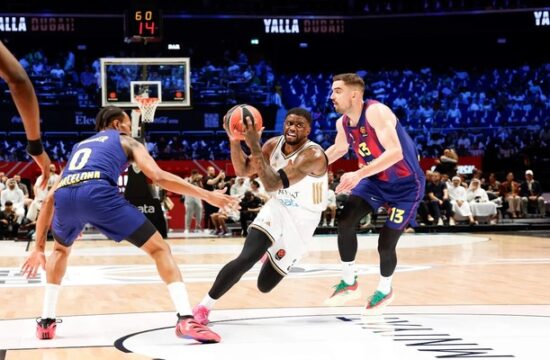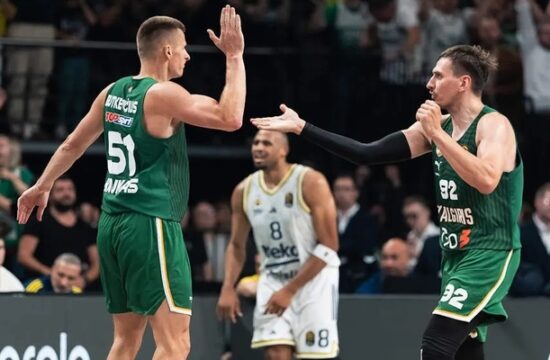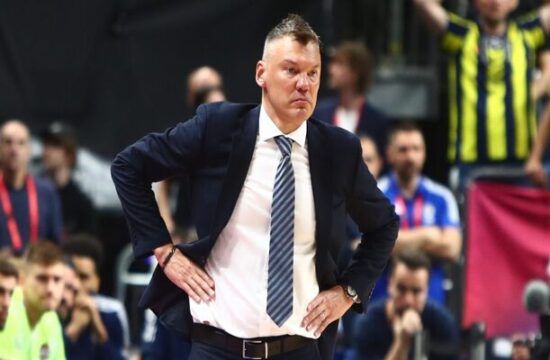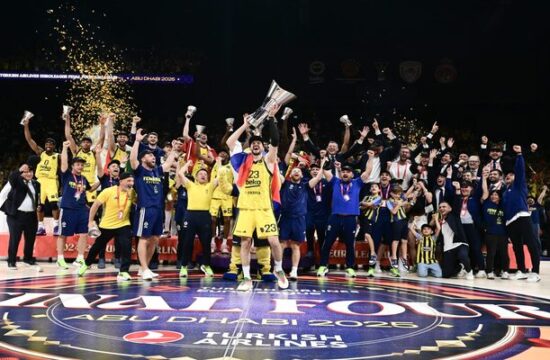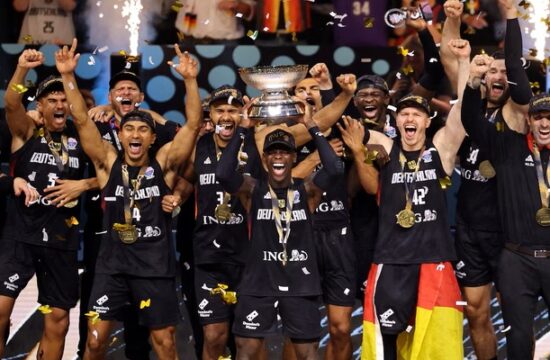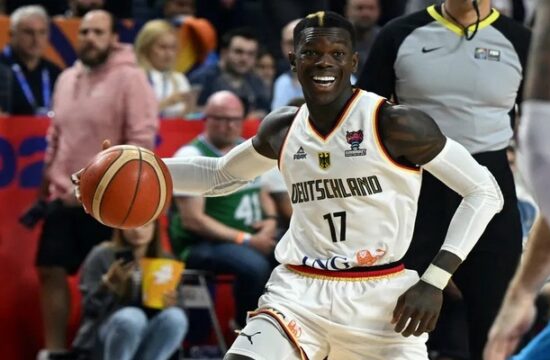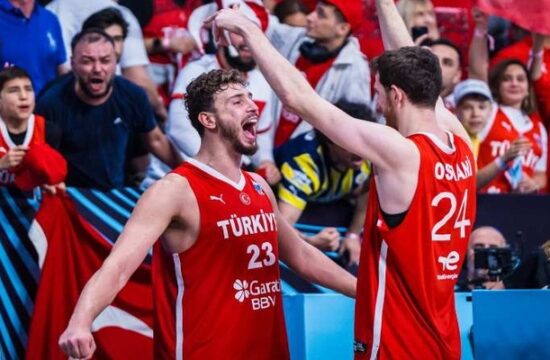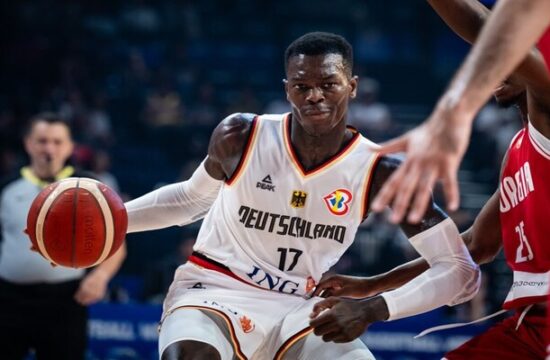The Games of week 4:
EA7 Milano vs Valencia: Valencia Survives Milano Comeback in Thrilling 103-100 Win
EA7 Milano vs Valencia delivered exactly the kind of EuroLeague thriller you hope for, and then some. Valencia traveled to Milano hoping to snap a three-game losing streak against an Armani team with the same 2-3 record, though coming off a road win against Zalgiris. The first minutes of the game were pure Milano style, low scoring, tight defense, 5-3 after three minutes, with Valencia struggling to get out and run. Their early 1-4 PnPop with Matt Costello wasn’t clicking. Pedro Martinez went to his bench early, and suddenly Valencia’s reserves dialed the intensity meter all the way up: full-court pressure, forcing turnovers, and turning them into easy points. Milano still punished Valencia’s switches with Booker on the short roll, but by midway through the first quarter, 10 Valencia players had already touched the floor. Exploiting Empty Corner actions and moving the ball side to side, Valencia tested the limits of Milano’s defense, which resorted to switching ball screens and fronting the post, but Valencia’s guards found open shots enough to offset Milano’s five offensive rebounds, a rare sight against this team. The first quarter ended 24-18 for Valencia, with the bench contributing 10 points.
Valencia came out prepared for Milano’s switch adjustments in the second quarter, sending a guard to “ghost” after switches, a move that led directly to Montero’s wide-open three and a Sako layup in a 5-0 run. Messina called a timeout, but Valencia kept riding the momentum, punctuated by Isaac Nogués’ defensive gem: poking the ball away from Marko Guduric, diving on the floor for the loose ball, and feeding Jaime Pradilla for a score. The lead hit 15 points with seven minutes left, forcing another Milano timeout. Valencia’s offense slowed down briefly, allowing Bolmaro to make some plays, but a 14-4 Milano run to close the half still left Valencia ahead 54-48, with Bolmaro already tallying 17 points at the break.
The third quarter began like the second ended: Bolmaro creating havoc and scoring, but Valencia’s threes soon began raining down. Nathan Reuvers, Pradilla, and Darius Thompson joined the party, hitting seven straight from deep, and Valencia’s lead ballooned to 20 points, forcing another Messina timeout. Eventually, Milano found cracks in the Valencia defense with a small-ball lineup featuring Ricci at the five spot, sparking a 12-4 run in the final 2:36 of the quarter and cutting the deficit from 22 to 11. Milano had life again, and the stage was set for a classic fourth quarter.
The fourth started with Milano continuing small-ball against Valencia, opening with a 7-2 run. Brooks hit four threes, cutting the lead to just two with 3:24 remaining. Omari Moore extended it to four, but Bolmaro wasn’t done, free throws brought it back to a two-point game. The final 2:50 became a clinic in tension: after a series of missed shots, Shields was frozen by an In-and-Out dribble from last year’s EuroCup Rising Star, who drained a clutch three to put Valencia up three with 43 seconds left. Bolmaro tried to answer, but Pradilla’s heads-up play tapped the ball out after a missed shot. Milano had a chance, but Shields’ contested three didn’t fall, leaving Valencia to escape 103-100.
For Valencia, this was more than just a win; it was a victory of the collective. Five players scored in double digits, two others just shy, and 11 players logged over 10 minutes. Pedro Martinez’s system continues to impress, moving the ball, attacking mismatches, and riding momentum. Bolmaro fought hard for Milano, scoring a career-high 31 points, but it wasn’t enough to overturn Valencia’s balanced attack. The game was a showcase of tactical adjustments, bench energy, and last-second heroics, and in a season full of parity, matchups like this are exactly what make EuroLeague must-watch TV.
Anadolu Efes vs Fenerbahçe
Blood runs hot in Istanbul, but never hotter than during the 40 minutes of a Turkish Derby and this one did not disappoint. Anadolu Efes came out firing, opening an 8-0 run that had the crowd on their feet. Fenerbahçe responded, punching back through Shane Larkin for four quick points, but their initial strategy of switching the PnR with Khem Birch on the floor was a mess. Efes attacked him relentlessly, with Weiler-Babb in particular making a statement, scoring eight points in just over six minutes. It wasn’t only him, all Efes guards were finding success, touching the paint, forcing rotations, and racking up assists; after one quarter, Efes already had eight assists on nine made field goals. Fenerbahçe’s shooting wasn’t pretty, but they hung around thanks to crashing the offensive glass, trailing 24-18 after the first.
The second quarter was a chess match. Fenerbahçe adjusted, dropping Bacot Jr. in the PnR and hedging with the others, but it mostly resulted in trading buckets. Saras called a timeout, and as usual, an ATO play sparked a 5-0 run that tied the game. Anadolu answered back, attacking opposing bigs in the PnR and getting to the free-throw line in a quarter full of whistles. Leads kept changing hands, and offense clearly had the upper hand, by halftime, Fenerbahçe held a narrow 44-43 lead. Their efficiency inside the arc (12/18) stood out against Efes’ smaller interior rotation, while the hosts relied more on the outside shot (6/14 from deep).
The second half turned into a grind. The third quarter started slow: 5-5 over the first three minutes, highlighted by Osmani picking up his fourth foul, thinning Fenerbahçe’s interior rotation and forcing Kokoskov into a four-guard lineup with PJ Dozier at the four. Defense tightened in Istanbul, points became scarce, and a Baldwin IV three with a Colson follow-up gave Fenerbahçe a five-point lead, forcing a timeout. Efes replied with a 5-0 run of their own, led by Larkin, and the quarter ended 15-14 in Efes’ favor, leaving it all tied going into the final period.
The fourth quarter belonged entirely to Fenerbahçe. They opened with a 6-0 run in the first minute and a half, and Efes never got closer than four points the rest of the way. Fenerbahçe’s defense, which had been building all game, now fully asserted itself. An Efes offense that had looked like a well-oiled machine in the first half suddenly looked out of sync, unable to find good shots. Hall’s three-pointer with 2:33 remaining felt like the dagger, Fenerbahçe up nine. They held on, winning 79-69, extending the road team’s dominance in the Istanbul Derby to 10 of the last 13 matchups.
Individually, Wade Baldwin flirted with a triple-double (10 points, 7 rebounds, 8 assists), or maybe even a quadruple-double if you count his seven turnovers. But it was Fenerbahçe’s collective defensive identity that won the day, holding Anadolu to just 9-of-26 shooting in the second half. For Efes, poor free-throw shooting (12-of-22) and an inability to consistently crack Fenerbahçe’s defense were decisive. Weller-Babb with 17 and Larkin with 13 points and nine assists tried valiantly, but it wasn’t enough. Istanbul bragging rights go to Fenerbahçe, at least until the next derby.
Virtus vs Panathinaikos
From the tip, this game was played at a high tempo, two teams looking to impose themselves, but Virtus came with a very clear plan: put size on Kendrick Nunn and take him out of the equation. With Karim Jallow matched up on him, 197 centimeters of length and athleticism, Virtus executed it perfectly. Nunn managed only five points in the first half, and that tells you just how disciplined Virtus’ defense was.
Scorers from both sides went to work early, Carsen Edwards and Nunn trading buckets, but Nunn’s night was cut short by Virtus’ elite defensive length and switching. On Panathinaikos’ side, Yurtseven was the lone center available and picked up two fouls in the first quarter, forcing a spell on the bench. Mitoglu slid to the five, Smailagic and Diof exploited inside, but it wasn’t enough to counter Virtus’ overall athleticism. Mathew Morgan stepped up when Carsen rested, handling scoring duties with confidence and poise, a marked improvement from his rookie season in Europe.
By halftime, Virtus had dictated the pace. They dominated the glass, forced seven turnovers, and slowed down everything Panathinaikos tried to do. Panathinaikos was never comfortable; their inside game was limited and their rhythm disrupted. Efficiency-wise, Virtus were on point, hitting their marks both inside and out, building a largest first-half lead of 15 before going to the locker room ahead by 13.
The second half saw Panathinaikos’s emotions boil over. Nunn picked up an unsportsmanlike foul and, with Ataman receiving two technicals and eventually ejected, Virtus capitalized, stretching the gap back to 13 after a Panathinaikos run at the start of the third. Even with Carsen off the floor, Virtus continued to score at a high clip. Panathinaikos elevated their defense, but their offense couldn’t keep up, only TJ Shorts was consistently producing, and Virtus’ lead climbed to 16 entering the fourth.
What makes Virtus dangerous is their versatility: their set plays generate looks inside and out, and they can punish a team in multiple ways. In the fourth, double teams on Nunn, executed by Hackett, Niang and Jallow, all elite defenders, were deadly effective. By the time the final buzzer sounded, Virtus was coasting to victory. Pajola flirted with a triple-double, and the team as a whole showed that if they carry this momentum forward, they might be a serious problem for the rest of the league.
This Virtus squad is not messing around: in their three games against Real, Monaco, and Panathinaikos, they held all opponents under 75 points, a statement of defensive dominance and a warning to anyone underestimating them this season.
Key Performances of the Past Week:
It’s time we shine a light on Nadir Hifi. The French guard has been quietly superb all season, but the Partizan game was when he truly stepped into the spotlight. In a hostile environment, Hifi put on a show, scoring 21 points, grabbing four rebounds, and dishing four assists in just 22:27 of playing time. Even more impressive? He did it while missing only three shots, 5-of-6 from two, 3-of-5 from deep, and a perfect 2-of-2 from the line.
What makes Hifi so captivating isn’t just the efficiency, it’s the way he wreaks havoc on defenses. He was able to dismantle every PnR defense Partizan threw at him. He attacked the teeth of the defense, breaking down defenders with his floater game and crafty finishes, turning what should have been contested shots into effortless points. There’s a kind of genius in the way he manipulates space and timing, and at just 23 years old, the ceiling feels endless. If EuroLeague fans are lucky, we’ll be watching Hifi dismantle defenses for many seasons to come.
Tammir Blatt deserves a spotlight after delivering one of those EuroLeague moments you tell friends about. Scoreless from behind the arc all game, he calmly drained the game-winning shot with just five seconds left. Beyond the dagger, Blatt’s stat line tells the story of a complete floor general: 12 points, 9 assists, 2 rebounds and only 2 turnovers in 27 minutes. Efficient, clutch, and unflappable. And then there’s Loonie, who had a night that made defenses regret every second they dared contest him. Dropping 27 points with zero turnovers, he was both the scorer and the engine, executing at an elite level while keeping the ball secure.
Standings Watch:
After six rounds, Hapoel is standing tall as the first clear leader of the EuroLeague with a 5-1 record. The Israelis have been a force on offense, topping both O-Rating and effective field goal percentage, and leaning heavily on the long-range shot, 25 attempts per game at an eye-popping 40% efficiency. Vasilije Micić deserves a nod here, looking like vintage Micić, scoring with ease while also leading the team in assists, orchestrating the offense like a maestro who never misses a beat.
Defense, too, has been steadily improving. The advanced stats show Hapoel comfortably in the top half of the league in D-Rating, a sign that this isn’t just a flash in the pan. It’s early, sure, but the message they’re sending is loud and unmistakable: We are here to win. And with the way they’re running, shooting, and distributing, the rest of the EuroLeague would be wise to take notice.
Week 5 Games to Watch:
Valencia vs Fenerbahçe
Valencia vs Fenerbahçe is a no-brainer for any basketball fan. Two of the most exciting teams in the competition square off in an arena that might not yet have the mythic history of “La Fonteta,” but the Roig Arena is ready to be a nightmare for anyone stepping on the court.
Both teams enter with a 3-3 record, each hungry to add another W to the column. The clash is a study in contrasts: different styles, elite talent on the floor and on the bench, and coaching masterminds orchestrating it all. Pedro Martínez and Šarūnas Jasikevičius are two of European basketball’s sharpest minds, and in this matchup, we get a front-row seat to their chess match, where only one team will leave standing at the end.
Olympiacos vs Hapoel
Olympiacos vs Hapoel is shaping up as another heavyweight clash at the top of the standings, promising edge-of-your-seat action from the first tip to the final buzzer.
The Peace and Friendship Stadium will roar as usual for the hosts, creating one of the most intimidating atmospheres in Europe. But Hapoel remains undefeated on the road, meaning someone’s streak will end by the final horn. On paper, the matchup is tight: two of EuroLeague’s best offenses going up against defenses that are at least above average, with Olympiacos leaning a bit more on the hedge.
Everything points to a razor-close contest, the kind of game you simply cannot miss.
Zalgiris vs Virtus
Zalgiris vs Virtus is shaping up as a must-watch for any fan who loves elite guard play. Both teams are flying high and operate fast, fun systems that push the pace and lean on full-bench rotations to keep fresh legs and new solutions on the floor. Zalgiris has defensive options ready to contain Carsen Edwards, Syrvidis, for example, but that only raises the stakes for Matthew Morgan. He’ll need to be in peak form, both facilitating for Carsen and producing himself, because in a game like this, every creation and every bucket matters.
What’s at Stake:
Anadolu Efes has started the season on a sour note. Built to compete at the very top, this team finds itself in 18th place after six games, with only two wins to show for all that talent.
It’s not a lack of skill, the roster is stacked, the offense is beautifully designed, but cohesion is still a work in progress. Moments that should have been controlled, like the fourth quarter against Fenerbahçe, have exposed cracks. On the other end, a struggling defense has only compounded the issues.
Sure, time will smooth some of these wrinkles. But in a league where “every game matters,” waiting might be too late. Coach Kokoskov has a steep climb ahead, trying to accelerate that process and make sure a team this talented doesn’t become the season’s biggest disappointment.
EuroLeague Headlines:
It’s been a busy week in EuroLeague front offices, with teams shaking up rosters and bringing in fresh faces to tilt the balance.
Bruno Fernando finally found a new home. His stint in Madrid didn’t pan out as hoped, but the Angolan center now gets a chance to start fresh in Belgrade, giving Partizan a different profile at center and some badly needed depth.
Across town, Crvena Zvezda dipped into the NBA pool as well, snagging Jared Butler to add another scoring option to a backcourt thinned by injuries. Valencia made a similar move, bringing in Braxton Key. With 37 NBA games under his belt and a G-League Defensive Player of the Year award last season, the American forward arrives ready to contribute to team success in a tangible way.
And then there’s the big splash: Spencer Dinwiddie. The 10-year NBA veteran, who averages roughly 13 points and 5 assists for his career, is joining FC Bayern. Experience, self-creation, someone who can take over a moment when it matters most, the kind of player a playoff-hungry team dreams about. Whether it’s enough for a serious push remains to be seen.
EuroLeague was already overflowing with elite talent, and now it’s even deeper. Rumors suggest the movement isn’t slowing down anytime soon, and that only makes the race for the playoffs even juicier.
This article was written by the European Hoops team: Tiago Cordeiro, João Caeiro and André Lemos. Make sure you give us a follow on Twitter at @EthosEuroleague!

